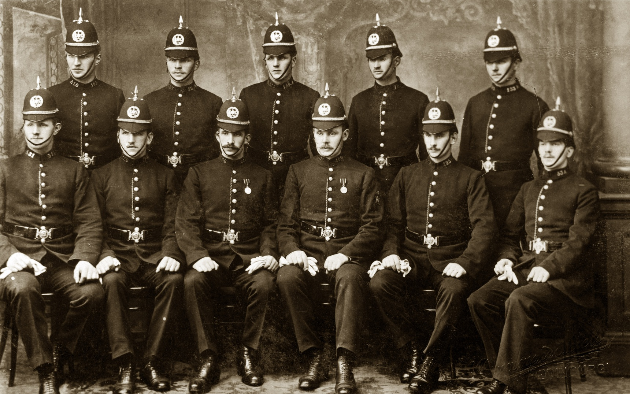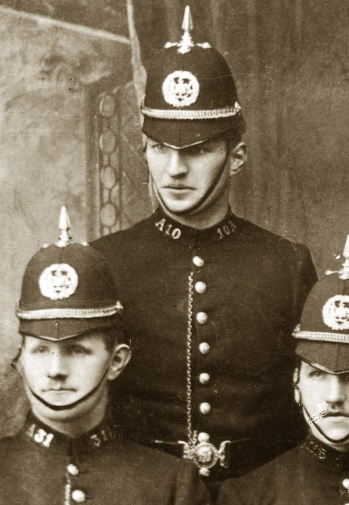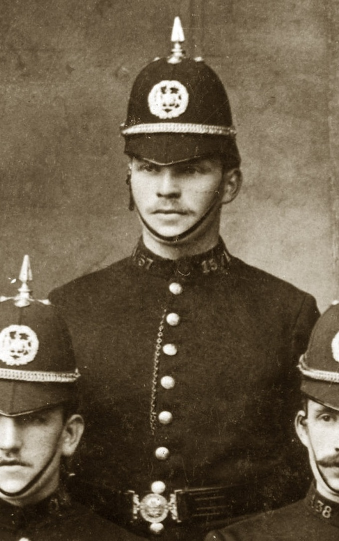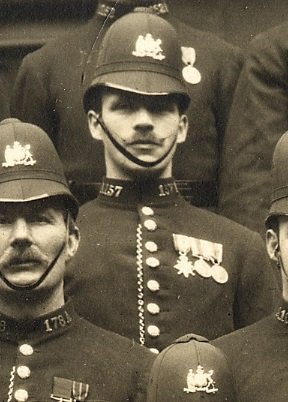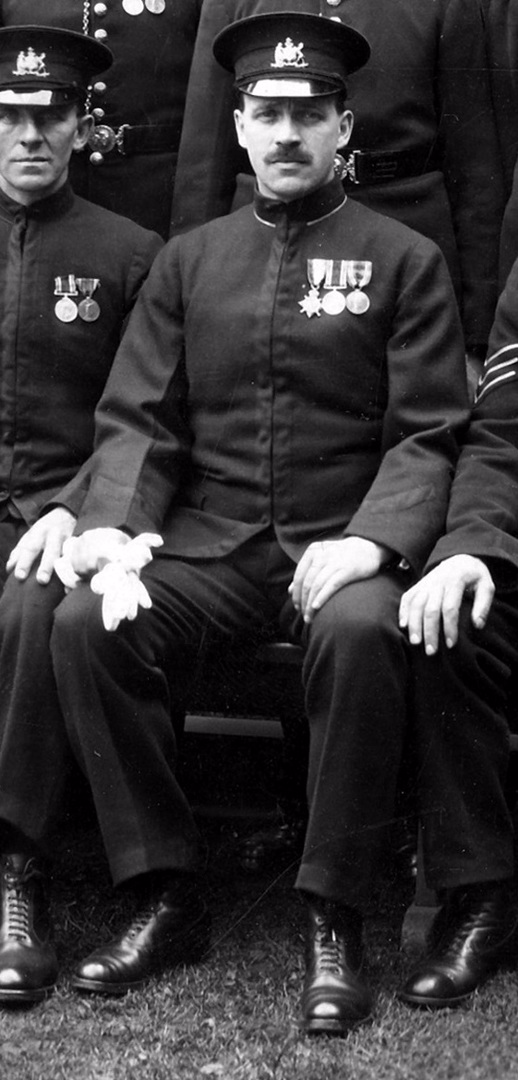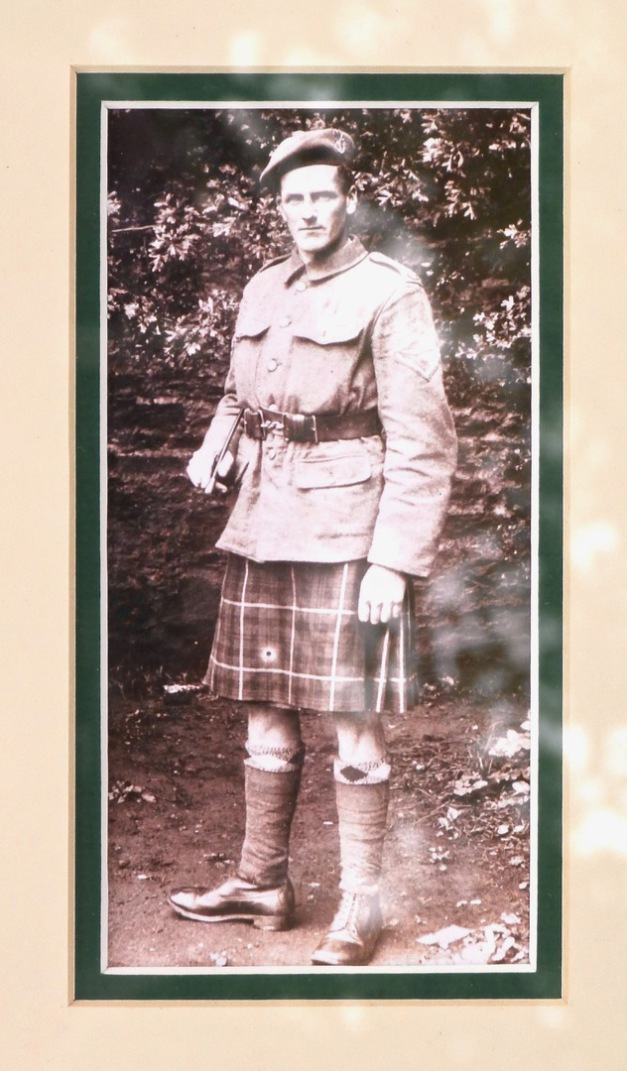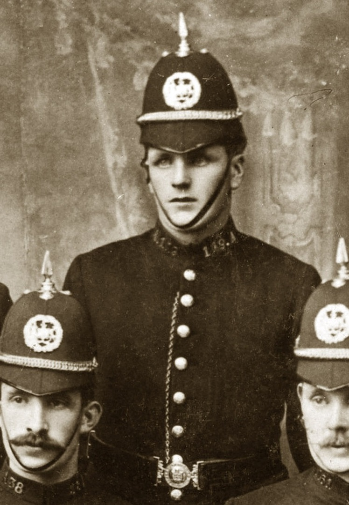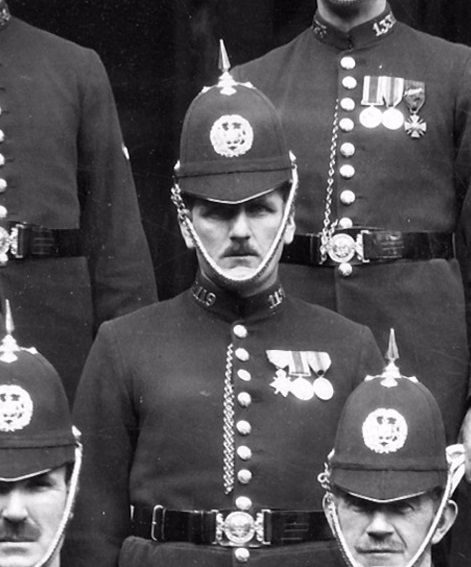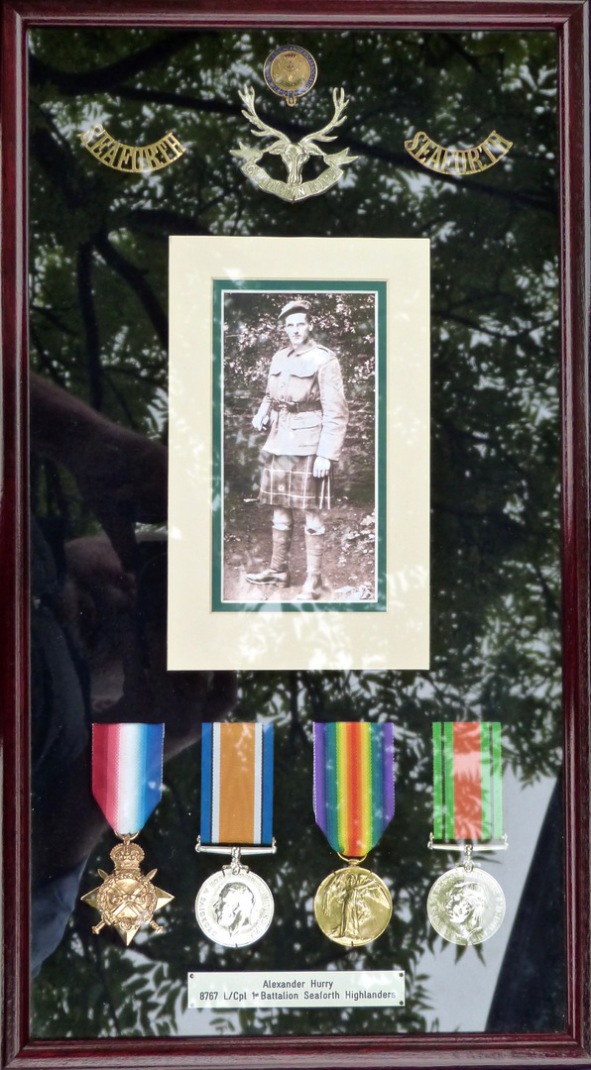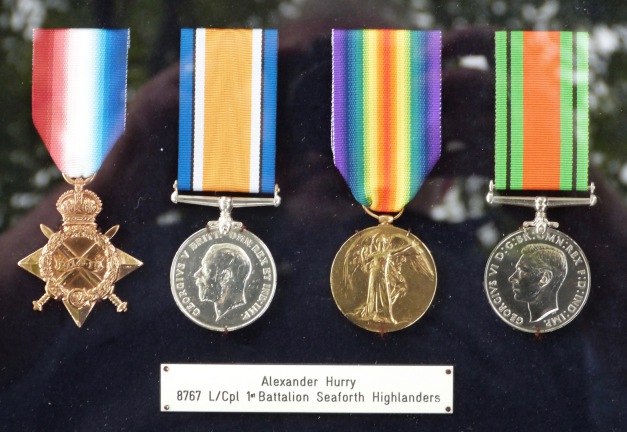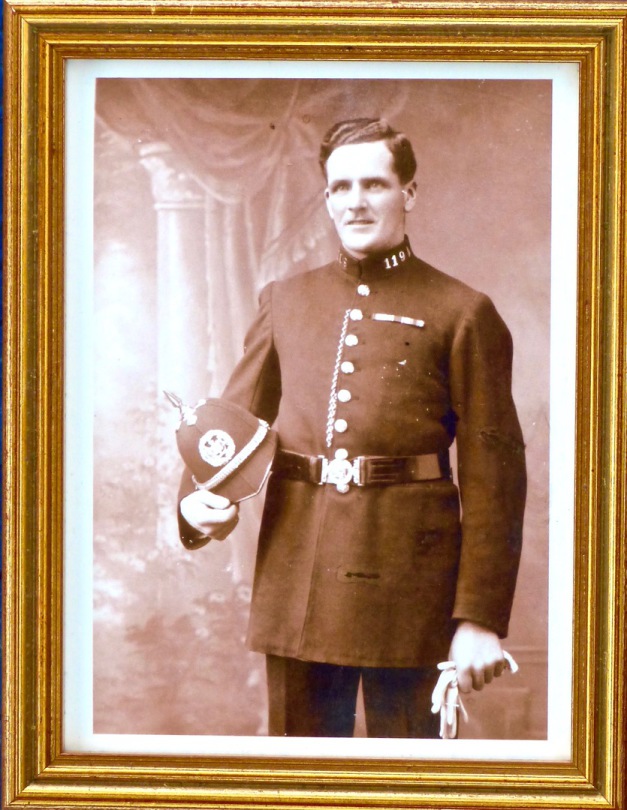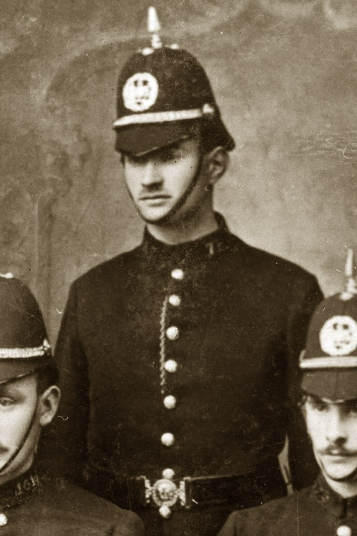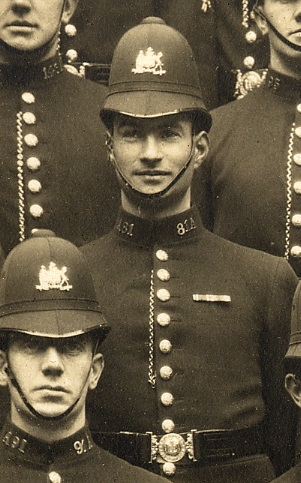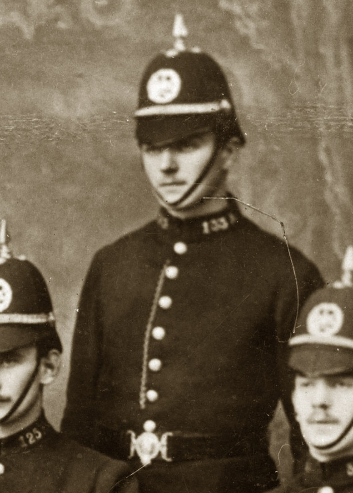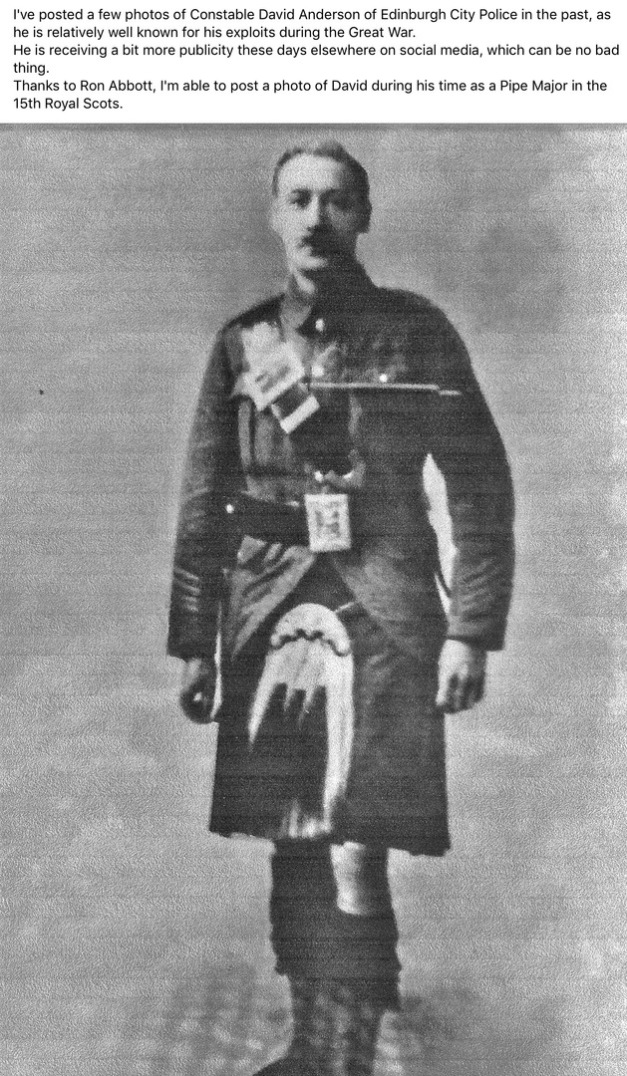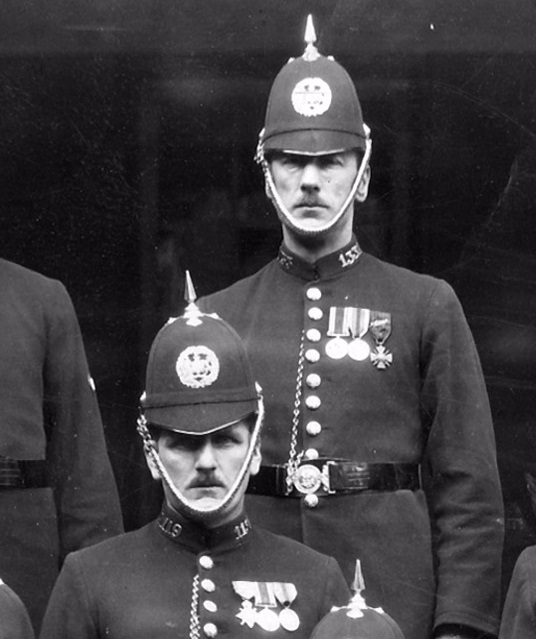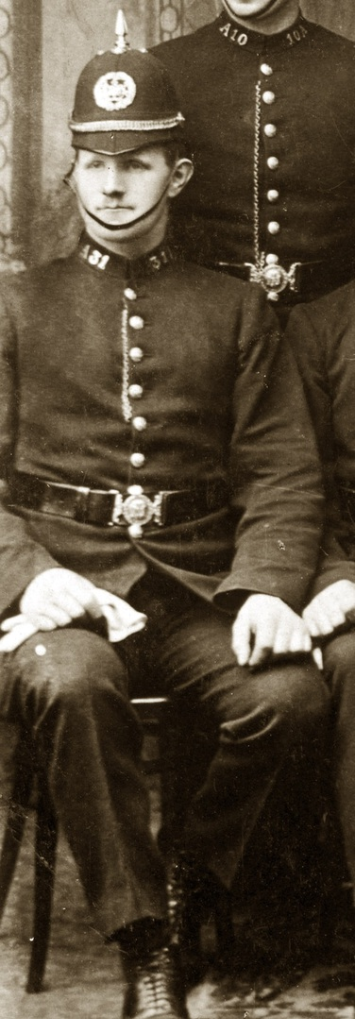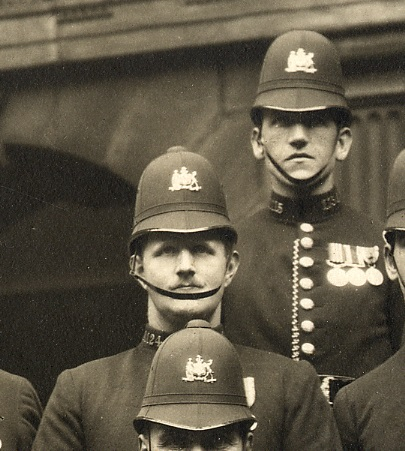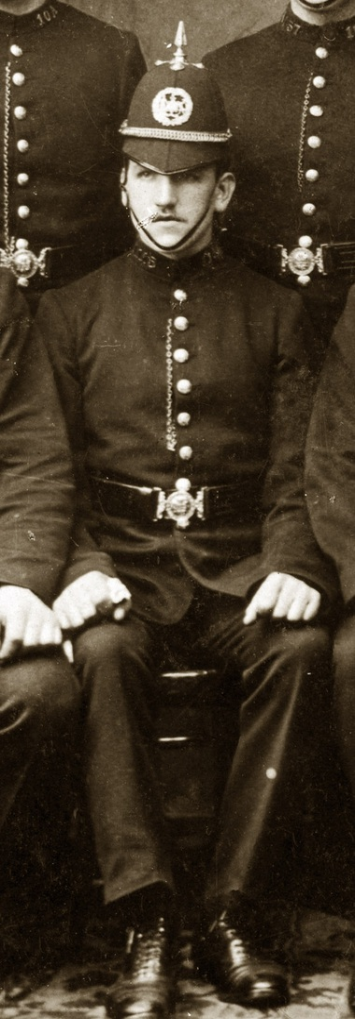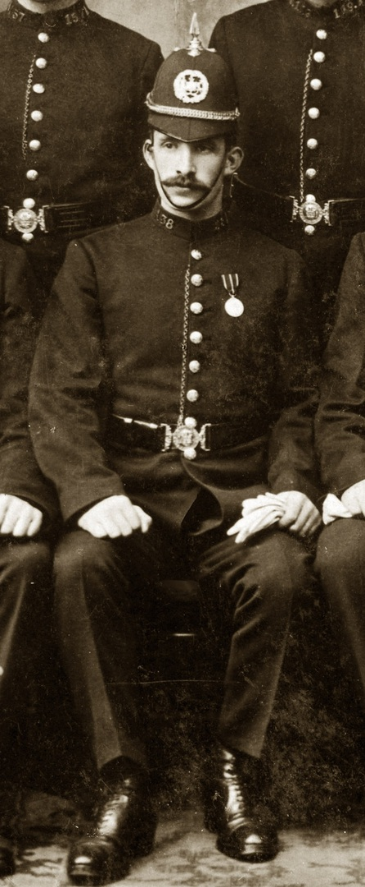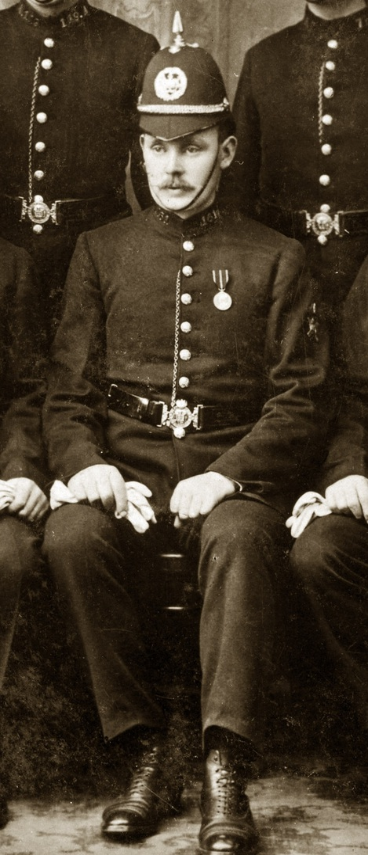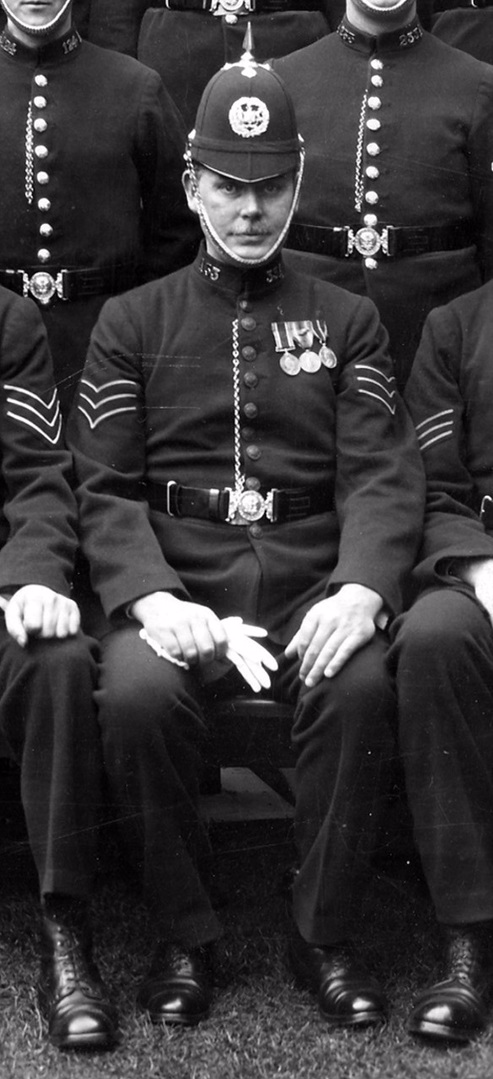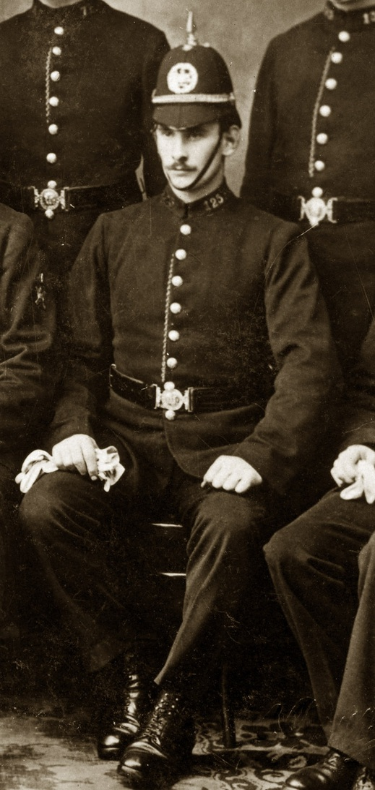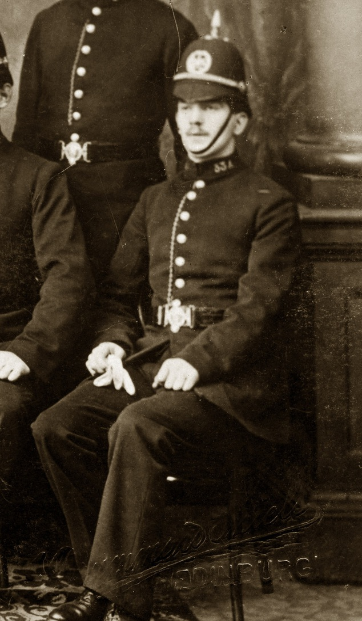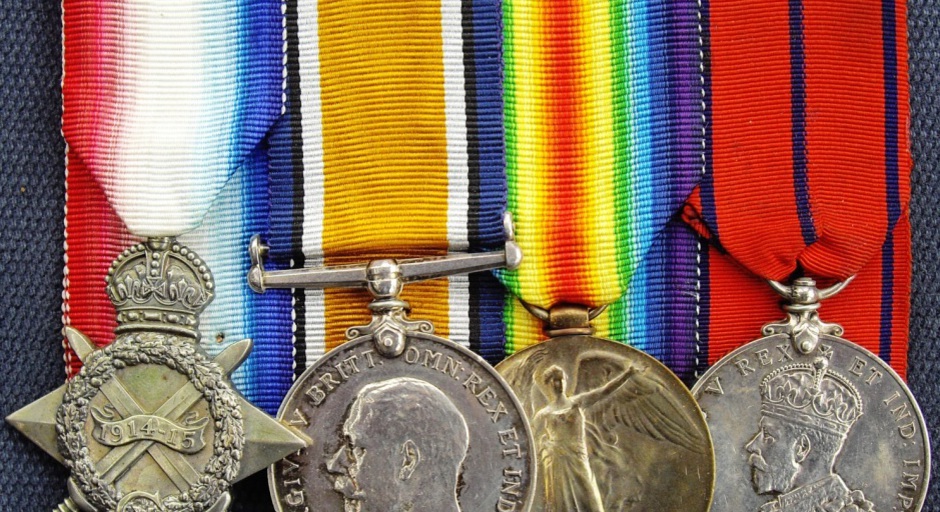
Edinburgh City Police 'A' Division officers prior to enlistment circa 1914?
Back Row L – R
PC 10 A Donald William Campbell, PC157 A John Watt, PC 119 A Alexander Hurry, PC 7 A Thomas MacIntosh, PC133 A David Anderson.
Sitting L – R
PC 31 A Stewart Mein, PC 115 A Andrew Joseph Ross, PC 38 A Robert Reid, PC 161 A Peter Cameron, PC 125 A, Alexander Weir, PC 33 A Allan Manson
PC 10 ‘A’ Donald William Campbell
Edinburgh City Police
Donald William Campbell joined Edinburgh City Police on 6 October, 1914 and was posted to A Division.
He resigned on 1 June, 1915 to enlist in the Seaforth Highlanders where he became a Lance Corporal.
He was ‘Killed in action’ possibly as Lance Corporal No. S/8778 with the 1st Battalion in France but I am unable to confirm that.
If you are able to confirm any details on Donald William Campbell, please get in touch with the website. Thank you.
PC 157 ‘A’ John Watt
Edinburgh City Police
John Watt was born on 13 October, 1892 in Broughton in the County of Peebles.
He was a ‘Carter’ when he joined Edinburgh City Police on 15 September, 1914 as PC 157 ‘A’.
He resigned on 31 May, 1915 to enlist in the Seaforth Highlanders where he became a Corporal.
He was re-appointed to the force on 4 March, 1919. His record shows he is entitled to the 1914-15 Star, the General Service Medal and the Victory Medal. He can be seen wearing his medals in the picture immediately below.
On 29 November, 1938, he was promoted to Sergeant and transferred to ‘B’ Division as PS 53 B.
He retired on pension on 1 April, 1946.
PC 119 ‘A’ Alexander Hurry
Edinburgh City Police
Alexander Hurry was born on 11 September, 1890 in Auchterarder in the County of Perth.
He was a ‘Porter when he joined Edinburgh City Police on 30 January, 1912. PC 119 ‘A’.
He resigned on 31 May, 1915 to enlist in the Seaforth Highlanders.
He was re-appointed to the force on 4 February, 1919. His record shows he is entitled to the 1915 Star, the General Service Medal and the Victory Medal. (See the picture of PC 133 'A' and PC Hurry in Ceremonial Dress in 1928).
He was ‘Commended’ or ‘Highly Commended’ by the Chief Constable six times between September, 1926 and July, 1933, all, with one exception, for “the arrest of thieves”.
In 1935 he was transferred to the Court Department as PC 18 HQ.
He retired on pension on 31 March, 1947.
PC 7 ‘A’ Thomas MacIntosh
Edinburgh City Police
Thomas MacIntosh was born on 21 September, 1894 in Colinton in the County of Midlothian.
He was a ‘Carter when he joined Edinburgh City Police on 1 September, 1914 as PC 7 ‘A’.
He resigned on 31 May, 1915 to enlist in the Royal Garrison Artillery as a Gunner 54570. He was later posted to 265 Siege Battery, 22nd Brigade in the British Expeditionary Force in France.
He was re-appointed to the force on 11 March, 1919. His record shows he is entitled to the General Service Medal and the Victory Medal. He can be seen wearing the medal ribbons in the picture below taken in 1922 as PC 81 'A'.
He retired on pension on 26 September, 1944.
PC 133 ‘A’ David Anderson
Edinburgh City Police
PC 133 ‘A’ David Anderson
Edinburgh City Police
David Anderson was born in Edinburgh on 15 January, 1890.
He was a Locomotive ‘Fireman’ when he joined Edinburgh City Police on 19 September, 1911 as PC 133 ‘A’.
He resigned for the purpose of “Joining the Army” on 8 October, 1914 and eventually became Serjeant Number 17017, in the 15th (1st City of Edinburgh) Battalion) Royal Scots (New Army) (Cranston’s Battalion). He is recorded in the Corporation of Edinburgh ‘Roll of Employees who served in the War’ as ‘Pipe-major in the Royal Scots’.
He played the Regimental March ‘Dumbarton’s Drums’ as the soldiers of the Battalion began the assault in the first day of the Battle of the Somme on 1 July, 1916. He carried on playing until he was eventually wounded.
The Supplement to the London Gazette of Friday 8 December, 1916 records that:
“The President of the French Republic has bestowed the decoration “Croix de Guerre” on the undermentioned Officers, Non-Commissioned Officers and Men, in recognition of their distinguished service during the campaign”:-
On Page 12040 of the Supplement, after the list of Officers is the entry:
“17017 Acting Sergeant David Anderson, Royal Scots”
He was re-appointed to the force on 7 July, 1919. His Medal Index Card and the Medal Roll of the Royal Scots shows he is entitled to the British War (General Service) Medal and the Victory Medal in addition to his Croix de Guerre. He can be seen, still in ‘A’ Division, wearing the medals in Ceremonial uniform in 1928.
He was ‘Commended’ or ‘Highly Commended’ for the arrest of ‘thieves’ or ‘known thieves’ in 1925, 1936, 1939 and 1940.
He retired on pension on 24 September, 1945.
I believe he died in 1967.
UPDATE:
1 July, 2016
On this, the 100th Anniversary of the First Day of the Battle of the Somme, BBC Radio Scotland ran a series of short clips of accounts by relatives of men who fought, died and lived during the 1st day of the Battle of the Somme, 1 July, 1916.
Among those short stories were those of Joanna Wright, a Toronto Police officer and her brother, Major David Wright of the Canadian Armed Forces.
Joanna and David are the Great Granddaughter and Great Grandson of PC David Anderson.
Their moving stories are told in two excerpts that can be found on BBC Radio Scotland.
Joanna’s story can be found at http://www.bbc.co.uk/programmes/p03zsjrb
David’s story can be found at http://www.bbc.co.uk/programmes/p03zskjfre
Joanna & David's story can be found at http://www.bbc.co.uk/programmes/p03znp0r
If you know of any other pictures or newspaper articles concerning PC David Anderson, please get in touch with the website. Thank you.
PC 31‘A’ Stewart Mein
Edinburgh City Police
PC 31 ‘A’ Stewart Mein
Edinburgh City Police
Stewart Mein, according to his Edinburgh City Police personnel record, was born in St Boswells (Roxburgh) in the County of ‘Berwick’ on 24 June, 1888. He was actually born at Millfield in the Parish of Mertoun in Berwickshire.
He was a ‘Farm Servant’ when he joined Edinburgh City Police on 4 June, 1912 as PC 31 ‘A’.
He resigned for the purpose of “Joining the Army” on 31 May, 1915.
The Edinburgh Corporation “Roll of Employees, Serving, or who have served, in His Majesty’s Forces during the War”, lists “Stewart Mein, Sergeant, Royal Scots (enlisted) May, 1915”.
The only Sergeant Stewart Mein I can find in Medal Index Cards (MIC) is 204268, Sergeant in 5/6th Battalion Scottish Rifles (Cameronians).
The Cameronian MIC shows his entitlement to the British War Medal and Victory Medal. He can be seen below as PC 124 A (in 1922) wearing the medals.
If you can confirm which regiments is correct, please contact the website and I will update the entry.
He was re-appointed to the force on 18 February, 1919 and rejoined ‘A‘ Division.
He retired on pension on 8 June, 1942.
PC 115 ‘A’ Andrew Joseph Garrigan Ross MM
Edinburgh City Police
Andrew Joseph Garrigan Ross was born at 12 Oakbank in the Parish of Liberton in Midlothian on 1 August, 1888. His father was James Ross, a ‘Fireman’ in the Oil Works and his mother was Bridget Garrigan or Ross.
By the Census of 1911, the family were living at 15 St Mary Street in Edinburgh which runs between the junction of the High Street and Canongate down to the junction of Holyrood Road, the Cowgate and the Pleasance.
James Ross was a ‘Stoker’ and his eldest son, Andrew was also a ‘Stoker’ in a ‘Distillery’.
He was a ‘Fireman’ when he joined Edinburgh City Police on 7 November, 1911 as PC 115 ‘A’.
He resigned for the purpose of “Joining the Army” on 31 May, 1915.
The Edinburgh Corporation “Roll of Employees, Serving, or who have served, in His Majesty’s Forces during the War”, lists “Andrew Ross, Sergeant, Royal Scots (enlisted) May, 1915”.
Andrew Ross enlisted in either the 5th Battalion Royal Scots (Queen’s Edinburgh Rifles) (Territorial Force) or the 6th (Service) Battalion. I am not sure which but on 15 June, 1916, both Battalions amalgamated to form 5/6th Battalion Royal Scots (Queen’s Edinburgh Rifles) as part of the 14th Brigade in the 32nd Division in France and Belgium. His Army Number was 275888.
The Supplement to the London Gazette of 19 November, 1917 lists Non-Commissioned Officers and Men awarded the Military Medal. Among them are:
“275888, Sjt. A. Ross, R. Scots (Edinburgh)”
I have no further details so if you can add any more information, please contact me via the website.
His Medal Index Card (MIC) and the Royal Scots Medal Roll both confirm his entitlement to the British War Medal and Victory Medal. He can be seen in the picture immediately above, still as PC 115 A (in 1922) wearing the medals.
He was re-appointed to the force on 11 February, 1919 and rejoined ‘A‘ Division.
He retired on pension on 10 November, 1941.
PC 38 ‘A’ Robert Reid
Edinburgh City Police
Robert Reid was born on 13 January, 1887 at New Deer in the County of Aberdeen.
He was a Police Constable with Midlothian Constabulary for 1 year and 4 months before he joined Edinburgh City Police on 20 September, 1910 as PC 38 ‘A’.
In the Census of 1911, he was living as a ‘Boarder’ at 124 Laurieston Place, Edinburgh.
Along with every other officer in Edinburgh City Police, he was awarded the King George V Coronation (Scottish Police) Medal, 1911 and he can be seen wearing it in the picture to the left.
On 31 May, 1915, he resigned for the purpose of “Joining the Army”.
The Edinburgh Corporation “Roll of Employees, Serving, or who have served, in His Majesty’s Forces during the War”, lists “Robert Reid, Lance Corporal, Seaforth Highlanders, (enlisted) May, 1915”.
Unfortunately, there are too many options of ‘Lance corporals in the Seaforth Highlanders’ called ‘Robert Reid’ in the Medal Index Cards so I am unable to identify him further. If you are able to provide more details, please get in touch with the website.
He was re-appointed to the force on 4 March, 1919 and rejoined ‘A‘ Division, still as PC 38 ‘A’.
On 17 September, 1929, he was promoted to Sergeant.
He retired on pension on 24 April, 1939.
PC 161 ‘A’ Peter Sinclair Cameron
Edinburgh City Police
Peter Sinclair Cameron was born in Cadderly, Archattan in the County of Argyll on 26 July, 1884.
He was a Police Constable with Argyll County Constabulary for 3 years before he joined Edinburgh City Police on 27 August, 1907 as PC 161 ‘A’.
In the Census of 1911, he was living as a ‘Boarder’ at 3 West Preston Street, Edinburgh. He was ‘single’ and a speaker of ‘Gaelic and English’.
Along with every other officer in Edinburgh City Police, he was awarded the King George V Coronation (Scottish Police) Medal, 1911 and he can be seen wearing it in the picture to the left.
On 31 May, 1915, he resigned for the purpose of “Joining the Army”.
The Edinburgh Corporation “Roll of Employees, Serving, or who have served, in His Majesty’s Forces during the War”, lists “Peter Cameron, Bombardier, Royal Garrison Artillery, (enlisted) May, 1915”.
He was living at 27 Meadowbank Crescent in Edinburgh with his wife Alexandrina Robertson or Cameron and their son, John, aged only one year old when he enlisted on 31 May, 1915 at Cockburn Street, just off the High Street. His Army Number was 54569 and he was posted to the 92nd Siege Battery, Royal Garrison Artillery.
He landed in France on 26 January, 1916.
His Army papers confirm his entitlement to the British war Medal and the Victory Medal. He can be seen wearing his three medals in Ceremonial dress in 1929 in the picture immediately below. The wearing of the bronze Oak Leaf on the Victory Medal signifies that he was 'Mentioned in Despatches' during his service.
He was re-appointed to the force on 18 February, 1919 and rejoined ‘A’ Division, still as PC 161 ‘A’.
On 29 July, 1929, he was promoted to Sergeant, still in ‘A’ Division as PS 33 ’A’.
He was promoted Inspector on 23 March, 1933 and transferred to Gayfield (‘B’ Division) as Inspector No. 20.
On 28 April, 1936, he transferred to Leith (‘D’ Division) as Inspector No. 28.
He retired on pension on 28 May, 1940.
PC 125 ‘A’ Alexander Weir
Edinburgh City Police
Alexander Weir joined Edinburgh City Police on 27 October, 1914 and was posted to ‘A’ Division as PC 125.
The previous PC 125 ‘A’, David Brunton Tarrant, joined on 29 April, 1913, had been an Army Reservist ‘Called to the Colours’ in 1914 and who ‘Died of Wounds in France on 29 September, 1914.
On 1 June, 1915, he resigned for the purpose of “Joining the Army”.
The Edinburgh Corporation “Roll of Employees, Serving, or who have served, in His Majesty’s Forces during the War”, lists “Alexander Weir, Private, Seaforth Highlanders, (enlisted) May, 1915”.
He was re-appointed to the force on 25 March, 1919 ‘A’ Division, still as PC 125 ‘A’.
He resigned from the force on 5 April, 1920.
There are too many options of his name in the Medal Index Cards to identify the correct man and because he left in 1920, his Police Personnel Record was not retained.
If you can provide more information on PC Alexander Weir, please get in touch with the website.
PC 33 ‘A’ Allan Manson
Edinburgh City Police
Allan Manson was born on 7 November, 1886 in Turriff in the County of Aberdeen.
He was a ‘Farm Servant’ when he joined Edinburgh City Police on 1 January, 1907 as PC 33 ‘A’.
In common with every other officer in Edinburgh City Police, he was awarded the King George V Coronation (Scottish Police) Medal in 1911.
He served in ‘A’ Division, (later with the collar number 125 ‘A’), until 8 November, 1923 when he was transferred to ‘B’ Division as PC 381 B.
He was commended by the Chief Constable in 1923 for the arrest of a Shop breaker in Castle Street.
He retired from the force on 4 January, 1937.
